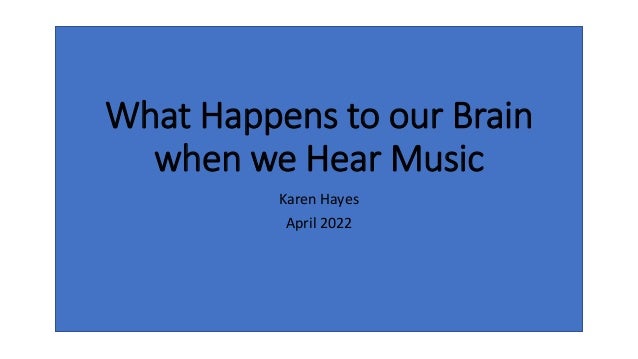
What Happens to our Brain when we Hear MusicFinal Assignment .pptx
- 1. What Happens to our Brain when we Hear Music Karen Hayes April 2022
- 2. Music is a part of our everyday lives. We hear it in the womb, as a baby and toddler, through childhood and into adult life. Zoltan Kodály was asked when music learning should start and famously said "Nine months before the birth of the child," moreover "nine months before the birth of the mother." We hear music. We have the ability to play and sing music. It has the capability to make us sad, happy, energized and reflective to name but a few. But what is happening in the brain whilst we are processing these soundwaves?
- 3. Hearing and the Ear A quick revision of the Hearing Pathways when music is heard: External Ear Pinna - gathers sound, like an ear horn Increases the magnitude of frequencies related to speech, decreases those related to anything else. Air wave hit the Timpanic Membrane which then vibrates. This is the border between the External Ear and Middle Ear Middle Ear Ossicles – the vibrations push on these 3 tiny bones, which push on the Oval Window changing the message from an airwave to a fluid wave in the Inner Ear Inner Ear Cochlea - in this auditory prism sounds of different frequencies are sent ot different parts of the spiral. Higher frequencies cross lower down, lower do so higher up. Cilia are linked by tiplinks – as the tip links are pulled open they reveal an ion channel and ions come flooding into the cell creating Electrial Impulses. Click here for an online diagram
- 4. What Happens Next? These are just some of the areas which are used in the processing of Music Frontal Lobe, esp. Prefrontal Cortex Thalamus Broca’s Area Wernicke’s Area Hippocampus Amygdala Cerebellum Corpus Callosum Nucleus Accumbens/ Ventral Striatum Putamen/Pallidum INNER EAR SENDS MESSAGE TO THE AUDITORY CORETEX (in the Temporal Lobe)
- 5. As the electrical impulses travel from the ear, the message that they carry is transferred to many different areas of the brain. For musicians (esp.professional) there will be even more areas which are activated as well as areas of the brain which are more highly activated due to the training they have had and the adaptations this has made to their brain(see here) The main pathway is shown below. Processing the music you hear Cochlia Brain Stem Decoding of duration, intensity & frequency Thalamus Integrates the sensory systems in the body – prepares a response. Used in high-level control in a performance setting and the cortico- thalamocortical network is highly delveloped in musicians (1) Auditory Cortex (Temporal Lobe) Processes the received message
- 6. Broca’s Area Emotive areas Think of the last film you watched, the advert in the middle of the latest series you are watching, that latest series you are watching! All of them will have music enhancing them, why is this so impactful on us as humans? There are areas in the brain which are specifically connected to the expressive quality of music – in you and the music. Originally thought to focus on word-based language, more recent research has also shown that this area is also used in expressing music when there are particularly complex harmonies, even in instrumental music (2) Amygdala As the area of the brain which is strongly connected with emotion, music is as strongly connected with the amygdala. When you listen to a haunting melody and feel a shiver down your spine, that is currently believed to originate from the Amygdala (3) Nucleus Accumbens (Basal Ganglia) An area where listening to music causes dopamine increases. This area is the same one that illegal drugs act on – you really can be a music addict.
- 7. Motor responses You know when you listen to a band, or you hear a great tune on the radio and your foot starts tapping? This is showing you that the electrical impulse which started with the drumstick hitting the drum (or perhaps even in the brain of the performer if you wish to go back further) has reached your Cerebellum and caused a response. The Putamen will be busy processing those rhythms from the drum and also helping co-ordinate your body movement When you get up to join in on the violin with the next track, your Cerebellum is still being activated, this time for the muscle memory response that you have spent hours, months and years building up and the Putamen is still helping with that co- ordination. Incidentally music increases the amount of dopamine produces in this last area which is creating interesting research into ways music can help Parkinson’s patients keep moving (4) You have also been storing the memories of this music and those practice sessions in your Hippocampus where the emotions connected to the music will make them easier to recall.
- 8. It seems that there are many areas of the brain that music activates. Music can make you feel happy, it can result in tears. A lot of research is ongoing in this fascinating area and, as in all areas of fast-moving research – sometimes the results take time. Some say that music developed as a proto language and use examples of modern-day motherese as evidence to support this. Some results in studies produce counter-weights to previous proclamations. However the science moves forward, music seems to hold an incredibly important role in our brains. And here is a little cheerful inducing tune: HAPPY - Pharell in Bermuda